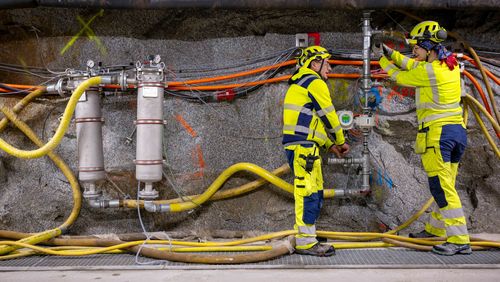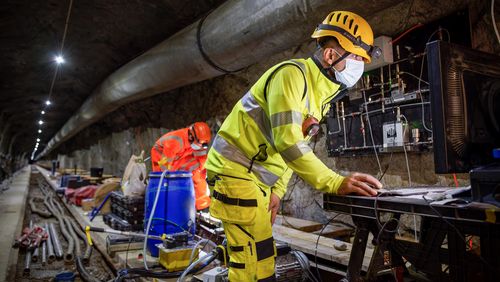![[Translate to English:] Die Geobiologin Cara Magnabosco sucht im BedrettoLab nach Mikroorganismen, die tief unter der Erdoberfläche leben. Sie könnten Hinweise darauf geben, wie Leben entstehen konnte.](/fileadmin/_processed_/1/c/csm_01-WSS-NEWS-Bedretto_DSC8324_f8d525eec3.jpg)
Studying microbes in the Bedretto tunnel
The Bedretto Underground Laboratory was designed for experiments in geothermal energy and seismology. But the unique facility below the Swiss Alps also hosts other research projects, including one led by geobiologist Cara Magnabosco from ETH Zurich, who is studying microorganisms that live deep in the Earth’s subsurface—tiny beings that may harbour clues about how life began.
The BedrettoLab—located in a former ventilation arm of the Furka Base Tunnel below the Saint-Gotthard Massif in southern Switzerland—is no ordinary research facility. With funding from the Werner Siemens Foundation, ETH Zurich converted the ventilation arm into a state-of-the-art underground lab for research into deep geothermal energy and seismology. For several years now, researchers from across the globe have been conducting experiments in the lab, which lies 1.6 kilometres beneath the Earth’s surface at its deepest point.
The Bedretto’s appeal, however, extends beyond geologists and seismologists. It’s also ideal for geobiologists like Cara Magnabosco, assistant professor at ETH Zurich. She says the BedrettoLab represents a unique opportunity for her research into bacteria and other minuscule organisms that dwell inside rock layers in the deep terrestrial subsurface: “It’s estimated that more microorganisms live underground than on the Earth’s surface and in all bodies of water combined.”
Most people find it hard to believe that living organisms can thrive in rock as hard as the Rotondo Granite found in the Bedretto tunnel. But even in the subsurface, rock layers are interspersed with fractures and joints through which water flows—and where specialised microbes use geologically generated energy sources like carbon dioxide (CO2) and hydrogen (H2) to activate their metabolism. “Over time, entire biological communities arise,” Cara Magnabosco explains. Some species break down nutrients, while others benefit from the process. The organisms include symbionts, parasites, predators, even predators of predators.
Samples from rock joints
Accessing this hidden biodiversity is one of the biggest challenges facing geobiology researchers. To be sure, underground locations such as coal mines or oil fields can be used for conducting studies. However, these sites tend to have vertical access shafts, whereas a tunnel creates a horizontal pathway through the underground rock, enabling analysis of a cross section of the environment, as Magnabosco relates. And the Bedretto tunnel offers even more advantages: unlike nearly all underground road and railway tunnels, its walls aren’t roughcast with cement and concrete—making it possible for researchers to take samples of the organisms living inside the rock.
A few years ago, Cara Magnabosco launched the DELOS project to conduct studies in the BedrettoLab. DELOS stands for Deep Life Observatory, but it’s also a sly nod to the eponymous Greek island of Delos: in classical antiquity, no one was permitted to die on the sacred site. “Microorganisms in the BedrettoLab survive extreme conditions in the deep terrestrial subsurface,” Magnabosco says. “You could even say they refuse to die.”
To gain a better overall picture of microbial diversity in the BedrettoLab, Magnabosco set up monitoring stations at dozens of sites throughout the 5.2 kilometres of the tunnel. Most are designed to catch water that penetrates the natural rock fractures and joints. These samples are then sent to labs in Zurich for analysis, where researchers filter out the living organisms and then extract their genetic material.
![[Translate to English:] Magnabosco und ihr Team sammeln Wasserproben im Bedretto-Tunnel. In ihren Labors an der ETH Zürich extrahieren sie daraus Bakterien und andere Lebewesen und analysieren deren Erbgut.](/fileadmin/_processed_/6/d/csm_02-WSS-NEWS-Bedretto_DSC8392_c16ccfea34.jpg)
![[Translate to English:] Ein vielversprechender Ansatz: Kürzlich hat Cara Magnaboscos Forschungsgruppe die ersten Resultate ihrer Untersuchungen im BedrettoLab publiziert.](/fileadmin/_processed_/6/5/csm_03-WSS-NEWS-Bedretto_DSC8511_de8e6815b6.jpg)
Thousands of microbial variants
Recently, Cara Magnabosco and her research team published a study with the first findings from these analyses (*). The samples reveal astonishing biodiversity in the BedrettoLab, with researchers counting no fewer than fourteen thousand five hundred amplicon sequence variants (ASVs), the unit used to distinguish species of microorganisms. The variants stem from sixty-four different biological phyla, a level of diversity that surprised Magnabosco.
The composition of the various microbial communities also differs greatly across the measuring sites. “Roughly speaking, we found three ecotypes in which different groups of microbes were dominant,” Cara Magnabosco explains. Different species communities were found in shallower areas where groundwater still occurs, in rock zones with high water inflows, and in lower-lying, base-rich rock.
One of the team’s most exciting discoveries was a large proportion of ultra-small bacteria from the Patescibacteriaphylum. With a length of just two hundred nanometres (a billionth of a metre), these organisms are roughly ten times smaller than “normal” bacteria, and their genetic material is also much smaller than that of other bacteria. Magnabosco says the species is still largely unknown: “It looks like they split off from other bacterial groups early on in the geological history of Earth. In the BedrettoLab, we’re seeing that these organisms live on the surface of other bacteria, possibly due to their limited metabolic capabilities.”
Life-giving earthquakes?
Although these tiny creatures are interesting, Cara Magnabosco is even more intrigued by another discovery: the minor seismic tremors triggered by researchers in the lab caused temporary changes to the composition of a microbial community at one of the measuring sites. “The hydrochemical composition and microbial diversity changed after the seismic event,” she relates, “but they returned to their baseline conditions within a few weeks.” One explanation is that seismic activity may cause the rock fractures to open and close, thereby altering water inflows.
It’s also possible that newly forming fractures set off reactions in the rock that split water molecules into oxygen and hydrogen atoms. This process yields a highly reactive liquid that is toxic to living organisms, as Magnabosco explains. In the long term, however, these reactions bring energy-rich molecules to microbial communities in the terrestrial subsurface—and life regenerates. She says this suggests that such natural seismic occurrences may have been similarly responsible for delivering energy to early life forms on Earth.
Cara Magnabosco’s interest in the fundamental question of where and when life originated isn’t restricted to our own planet. At the ETH Zurich Centre for Origin and Prevalence of Life, she and her team are collaborating with other research groups to study the conditions needed for life to emerge on other planets as well. The reaction enabling rock and water to generate biochemical energy could also occur in the subsurface of other planets, Magnabosco says. In other words: shedding light on the microbes dwelling in the Bedretto tunnel could lead to a greater understanding of how life arises in distant worlds.
![[Translate to English:] Der 5,2 Kilometer lange Bedretto-Tunnel diente einst als Belüftungsstollen des Furka-Tunnels. Heute beherbergt er ein einzigartiges Untergrundlabor für die Tiefengeothermie- und Erdbebenforschung.](/fileadmin/_processed_/f/7/csm_04-WSS-NEWS-Bedretto_DSC4328_f0df88aace.jpg)

![[Translate to English:] Die Geobiologin Cara Magnabosco sucht im BedrettoLab nach Mikroorganismen, die tief unter der Erdoberfläche leben. Sie könnten Hinweise darauf geben, wie Leben entstehen konnte.](/fileadmin/_processed_/1/c/csm_01-WSS-NEWS-Bedretto_DSC8324_c8ea4a52fd.jpg)


